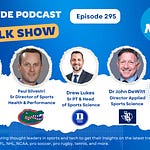Today we have the honor of interviewing Eric Renaghan, Executive Director of Sport Performance at the University of Miami a top NCAA organization.
Eric Renaghan leverages 15 years of elite sport experience to advance evidence-based athletic development programming for Miami Football and Track & Field. His career includes serving as Head of Sport Performance for the 2019 Stanley Cup Champion St. Louis Blues, performance roles with the Vancouver Canucks and San Jose Sharks, and an international leadership role as High-Performance Advisor to the Italian Ice Hockey Federation. Renaghan holds a Master of Science in Human Performance from Lindenwood University and a Bachelor of Science in Kinesiology from San Jose State University. He is currently completing doctoral studies in Applied Physiology, furthering his commitment to research-driven performance enhancement.
📝Show Notes: Through this interview, we touched on his background, and his role at the University of Miami. We also touched on what his typical day looks like. We also discussed his approach towards innovation, and how important technologies are to help better train his athletes and help them recover faster. We also touched on some of his favorite technologies and what he is looking for when him and his team are looking to adopt a new technologies. Eric also shared his thoughts on how he sees technologies impacting the University of Miami from a performance training, and recovery perspective in the future. Lastly he shared his thoughts on the type of technology he would build if he had unlimited resources.
You can read the full transcript of the podcast interview with Eric located at the top of this blog post.
Here are the quotes from the interview with Eric:
Q1. Please tell me about your background and your role at the University of Miami.
"For the past decade, I was in the NHL as a head strength and conditioning coach, most recently with the St. Louis Blues. Before that, I worked with the Vancouver Canucks and San Jose Sharks as an assistant strength and conditioning coach. My background has been primarily in hockey, working at the highest levels of the sport."
"Before coming to Miami, I was also the High-Performance Director for the Italian Ice Hockey Federation, working internationally. That experience gave me a much broader perspective on how different countries and systems approach athlete performance."
"I’ve been at the University of Miami for the past three years. I started as the Director of Sports Science for football and, as of January, moved into the Executive Director of Sport Performance role. While my background is mostly in hockey, the transition to football has been great. The two sports are much more similar than people think, especially in terms of the collision aspect and the physiological demands on athletes. There are differences, of course, particularly on the metabolic side, but I’ve really enjoyed bringing insights from hockey into football and track and field."
Q2. What does your typical day look like at the University of Miami?
"I started here as the Director of Sports Science for football, but my current role as Executive Director of Sport Performance is more about overseeing and coordinating everything we do from a performance standpoint. I still work closely with our football and track and field programs, but I now act as more of a conduit between departments, making sure communication flows smoothly across all performance domains."
"A big part of my role involves working closely with our head coach on things like load management, player recovery, and long-term performance planning. We’re constantly evaluating data and making individualized programming decisions for specific athletes."
"On any given day, my team and I are setting up and operating various technologies to monitor player performance, whether it’s practice, team conditioning, or weightlifting sessions. The specifics of what we do depend on the day’s training schedule and the needs of our athletes. My role is less hands-on than it used to be—I spend more time making sure that the right systems are in place and that we’re making data-driven decisions that actually improve performance."
Q3. What is your approach towards innovation? How important are technologies in training and recovery?
"For me, innovation isn’t just about adding more technology—it’s about doing things better. A lot of people think innovation means bringing in the newest gadget or tracking another data point, but that’s not really how I see it. To me, true innovation means improving communication, making smarter decisions, and becoming more efficient in how we train and recover."
"Technology is a powerful tool, but only if you know how to use it effectively. The key question we always ask is: Are we making a real impact on the program? Are we using the data we collect to make meaningful, informed decisions, or are we just tracking things for the sake of tracking them?"
"I have access to a massive amount of technology, but I actually focus on using fewer tools more effectively. Rather than chasing the latest trends, I want to make sure we’re fully utilizing the tools we already have to optimize training, improve recovery, and enhance player performance."
Q4. What are some of your favorite technologies that you use at the University of Miami? Why?
"If anyone knows me, they know I’m a big force plate guy. I’ve used force plates for almost 20 years, and Hawkin Dynamics has been a staple in my program since 2016. We use them across all our Olympic sports, including football. Force plates provide critical data on an athlete’s neuromuscular function, fatigue levels, and movement asymmetries, which allows us to customize training programs in real time."
"One of the most valuable wearables we use is the Warfighter Monitor, which was developed in partnership with the Department of Defense. It’s a small, high-precision wearable that allows us to track internal load metrics, including body temperature, ECG, heart rate variability, and physiological strain. Heat management is a huge factor for us in Miami, so we treat heat load just like mechanical or physiological load when making training decisions. With this monitor, we can see exactly how an athlete’s body is responding and adjust their workload accordingly."
"Another tool we rely on is CoolMitt, a cooling device we use on the sidelines during games and at practice. We had players using CoolMitt on the bench during our game against Florida this year, and it’s been a game-changer in terms of managing heat stress and improving endurance."
"We also do a lot of thermal imaging using FLIR cameras and ThermoHuman software. This allows us to track hydration levels and injury risk by detecting changes in skin temperature and blood flow. If we notice a discrepancy in the thermal imaging data, we can compare it with force plate metrics and biometric changes to determine whether an athlete is at risk for dehydration, fatigue, or injury."
Q5. When looking to adopt a new technology, what are the most important criteria?
"First and foremost, the technology has to be reliable and valid. Does it actually measure what it claims to measure? If the data isn’t valid, then it’s useless."
"Second, we ask: Will it move the needle? Will this technology actually enhance our program and provide actionable insights that improve player performance?"
"Fortunately, our university and football program are heavily invested in sports science, so cost isn’t always the primary concern. The bigger question is whether the technology fits into our workflow and integrates with our existing systems. We’ve built our own centralized AMS system using SQL, Power BI, and Python scripts, so any new technology needs to integrate seamlessly into that ecosystem rather than functioning as an isolated tool."
Q6. In the coming years, how do you see technologies impacting the University of Miami from a performance training and recovery perspective?
"The goal is to get better at doing less. Right now, there’s an overload of data in sports performance, and I think the future is about refining our process—analyzing data more effectively, filtering out noise, and focusing only on what truly impacts performance."
"In five years, I see us using technology more efficiently, ensuring that we’re giving athletes everything they need and nothing they don’t. The more precise we become in individualizing training and recovery, the less wasted effort there will be, and the more time we can spend on cognitive training and holistic athlete development."
Q7. What type of technology would you build if you had unlimited resources? Why?
"I’d build something straight out of Minority Report—an interactive system where I could pull up an athlete’s profile and instantly see their injury risk, workload, physiological status, and predictive analytics. If I wanted to know the risk of injury for a particular player, I could just drag their name onto the screen, and the system would tell me exactly what I need to know."
"We’re not too far from this with AI. We’re already using Cox regression analysis to predict potential injuries and performance trends, but automating this process and making it instantly actionable would be the ultimate game-changer."
You may also like:
⭐ Upside Analysis: Why the NCAA is the Next Big Opportunity for Startups
We have been working with teams in the MLS, NBA, NFL, NHL, MLB, NCAA, European soccer leagues, pro tennis, pro rugby as well as Olympic teams for over 10 years. Historically most sports tech startups have focused on the top professional teams (NBA, NFL, MLS, MLB, NHL). However, in the past few years we have seen a large number of sports tech startups in…
🎙️ Upside Chat with Jordan Troester, PhD, Director of Sports Performance & Sports Science (University of Oregon/NCAA)
Today we have the honor of interviewing Jordan Troester, PhD, the director of sports performance and sports science at the University of Oregon (UO), a top NCAA organization.













